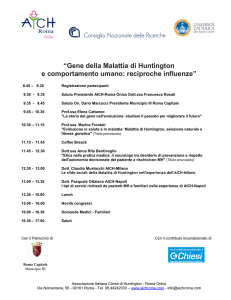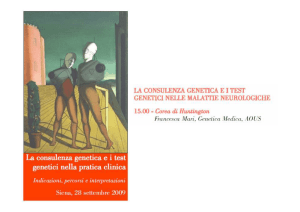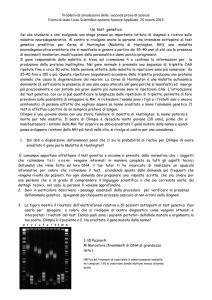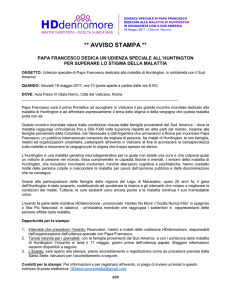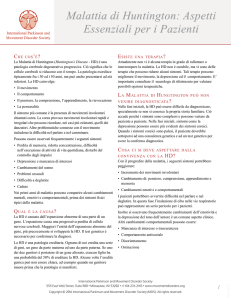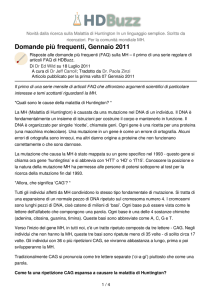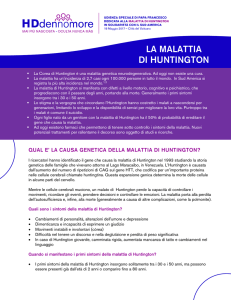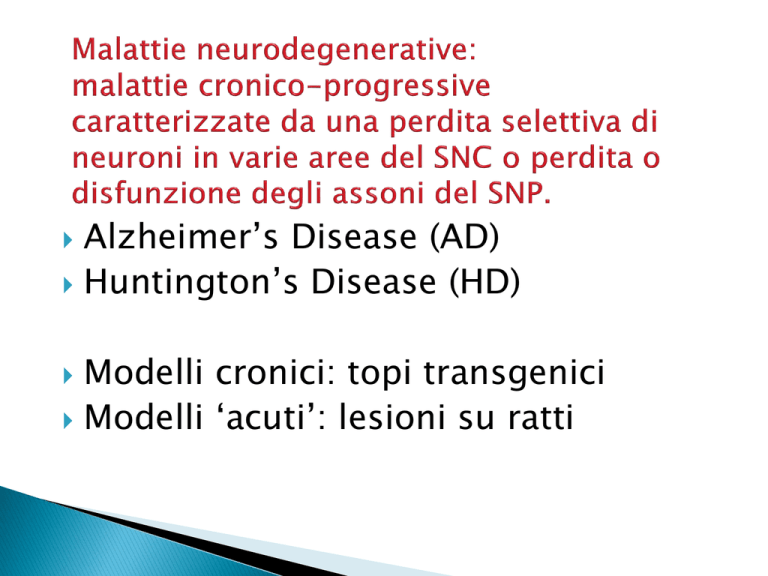
Alzheimer’s Disease (AD)
Huntington’s Disease (HD)
Modelli cronici: topi transgenici
Modelli ‘acuti’: lesioni su ratti
Huntington’s disease
is an autosomal dominant neurodegenerative disorder with midlife
onset, characterized by psychiatric, cognitive and motor symptoms.
HD is related to an abnormal CAG triplet repeat expansion (>>40)
within the HD gene (chromosome 4 p16.3, short arm) that codes
for a protein named Huntingtin.
HD is typically characterized by neurodegeneration of the striatum
and deep layers of cerebral cortex.
Moreover striatal Medium Spiny GABAergic neurons are
preferentially and progressively lost in the course of HD
What is Huntington disease?
Huntington disease is a progressive brain disorder that causes
uncontrolled movements, emotional problems, and loss of thinking
ability (cognition).
Adult-onset Huntington disease, the most common form of this
disorder, usually appears in a person's thirties or forties. Early signs
and symptoms can include irritability, depression, small involuntary
movements, poor coordination, and trouble learning new information
or making decisions. Many people with Huntington disease develop
involuntary jerking or twitching movements known as chorea. As the
disease progresses, these movements become more pronounced.
Affected individuals may have trouble walking, speaking, and
swallowing. People with this disorder also experience changes in
personality and a decline in thinking and reasoning abilities.
Individuals with the adult-onset form of Huntington disease usually
live about 15 to 20 years after signs and symptoms begin.
A less common form of Huntington disease known as the juvenile form
begins in childhood or adolescence. It also involves movement
problems and mental and emotional changes. Additional signs of the
juvenile form include slow movements, clumsiness, frequent falling,
rigidity, slurred speech, and drooling. School performance declines as
thinking and reasoning abilities become impaired.
How common is Huntington disease?
Huntington disease affects an estimated 3 to 7 per 100,000 people of
European ancestry. The disorder appears to be less common in some other
populations, including people of Japanese, Chinese, and African descent.
What genes are related to Huntington disease?
Mutations in the HTT gene cause Huntington disease. The HTT gene provides
instructions for making a protein called huntingtin. Although the function of
this protein is unknown, it appears to play an important role in nerve cells
(neurons) in the brain.
The HTT mutation that causes Huntington disease involves a DNA segment
known as a CAG trinucleotide repeat. This segment is made up of a series of
three DNA building blocks (cytosine, adenine, and guanine) that appear
multiple times in a row. Normally, the CAG segment is repeated 10 to 35
times within the gene. In people with Huntington disease, the CAG segment is
repeated 36 to more than 120 times. People with 36 to 39 CAG repeats may or
may not develop the signs and symptoms of Huntington disease, while people
with 40 or more repeats almost always develop the disorder.
An increase in the size of the CAG segment leads to the production of an
abnormally long version of the huntingtin protein. The elongated protein is cut
into smaller, toxic fragments that bind together and accumulate in neurons,
disrupting the normal functions of these cells. The dysfunction and eventual
death of neurons in certain areas of the brain underlie the signs and
symptoms of Huntington disease.
How do people inherit Huntington disease?
This condition is inherited in an autosomal dominant pattern, which
means one copy of the altered gene in each cell is sufficient to cause the
disorder. An affected person usually inherits the altered gene from one
affected parent. In rare cases, an individual with Huntington disease does
not have a parent with the disorder.
As the altered HTT gene is passed from one generation to the next, the
size of the CAG trinucleotide repeat often increases in size.
People with the adult-onset form of Huntington disease typically have 40
to 50 CAG repeats in the HTT gene, while people with the juvenile form of
the disorder tend to have more than 60 CAG repeats.
Individuals who have 27 to 35 CAG repeats in the HTT gene do not
develop Huntington disease, but they are at risk of having children who
will develop the disorder. As the gene is passed from parent to child, the
size of the CAG trinucleotide repeat may lengthen into the range
associated with Huntington disease (36 repeats or more).
Huntingtin functions :
required for embryonic development
involved in cellular vesicle trafficking, endocytosis and synaptic
function
role in survival of SNC cells (antiapoptotic)
Luogo e data
Htt in striatal neurons
increase the transcription of BDNF in cortical neurons
Degenerazione selettiva dei neuroni striatali che proiettano al Gpe
appartenenti alla via indiretta, con maggiore inibizione del NST.
Presenza di movimenti rapidi e non finalizzati, a scatto, che
compaiono in maniera irregolare.
Pathogenetic
Genetic
Quinolinic Acid
Transgenic mouse and rat
3-NP
Knock-in mouse
Lentivirus
Transgenic models: random insertion of full lenght or Exon-1human Htt
Ramaswamy et
al., ILAR J 2007
Knoch-in mouse
Inserimento della mutazione HD umana nel gene per l’Htt nel
topo (Hdh), che porta all’espressione dell’mHtt.
• no atrofia cerebrale
• microaggregati nucleari di mHtt nei 94 CAG
• gliosi e astrocitosi in striato e substantia nigra
• no perdita neuronale
• no deficit motori nei costrutti a 72-80 CAG
• deficit motori in quelli a 140-150 CAG
• diminuzione dei livelli di BDNF nei 109 CAG
•
Knock-in models
Ramaswamy et al., ILAR J 2007
Acido Quinolinico
Determina morte eccitotossica dei neuroni causa
un danno iperstimolando i neuroni fino alla
morte).
E’ prodotto in natura dal cervello come sostanza di scarto del
processo di degradazione delle proteine. L'attività di KMO
determina quale senso seguirà la catena di smontaggio delle
proteine.
Se KMO è più attiva, verrà prodotta la sostanza tossica Quin.
Se KMO è meno attiva, verrà prodotta invece Kyna, l'acido
chinurenico.
Gli effetti di Kyna sono opposti a quelli di Quin - Kyna infatti
protegge il cervello dai danni prodotti da sostanze chimiche
come Quin.
Stereotaxic coordinates:
0.5 rostral to Bregma
3.0 lateral to midline
5.0 ventral from
skull surface
The viruses were injected at
0.2 µL/min by an automatic
pomp and left in place for 5
min
Accelerod test
Beam walking test
Elevated Plus
maze
(2.3 and
1.2 cm)
Social interaction test of anxiety
Radial maze test
Immunohistochemistry for IC2 (monoclonal antibody for polyQ)
EM48 positive aggregates
Quantitative morphology analysis
(Ø 1.5 cm)
Measurement of motor
deficitis
•
•
•
•
•
swimming tank
beam walking test
rotarod
footprint test
PPI
FOOTPRINT ANALYSIS
BEAM WALKING TEST
ACCELEROD TEST
Training: 4 trials per 3 giorni
consecutivi a velocità costante, con un
intervallo di 5-10 min
TEST: 2 trials ad ogni velocità
incrementale
Si misura la latenza a cadere dal
rotarod
Conclusions:
The beam walking test and the footprint
test are good tools to study locomotor
deficit present in all animal models of HD.
Advantages:
Low cost
Easy to reproduce
‘spontaneous’ vs forced locomotion

